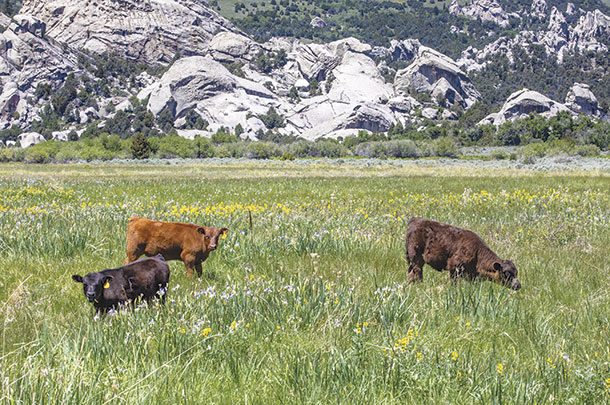During this stressful time, ranchers are faced with many critical decisions: Do I purchase hay and feed through the drought? Do I reduce stocking rates and sell cow-calf pairs and yearlings? Do I wean calves early? Do I drylot breed animals? Do I supplement the forage available? And how will I market my animals?
All are very important decisions with their own financial implications unique to every ranch and must be carefully evaluated. Given the great amount of stress placed on ranchers to address these questions, developing a sound drought management plan during the good years may help alleviate some of these stressful decisions when the drought years return.
Just as every factory needs a sturdy and healthy foundation to be sustainable, a rancher must keep a watchful eye on the natural resources of the ranch during a drought. The natural resources are the foundation for all other perspectives of a ranch. Other ranch perspectives may include production, financial, customers and quality of life.
The natural resources to a large extent also set the boundaries for each of the other perspectives on a ranch. The natural resources determine the number of cattle that can be stocked or the number of wildlife that can be sustained as well as the amount of forage crops or hay that can be produced. Striving to maintain the natural resources in the best condition as possible through a drought will be crucial for a fast recovery when conditions improve.
So how can a rancher best manage his or her rangeland resources before, during and after a drought? By adhering to some “ranching simple truths.” First, a rancher must understand drought is a normal occurrence. On a majority of ranches across the U.S., drought plays a major factor in ranch management. Drought is cyclical. Having a successful drought management plan integrated into the overall management plan of the ranch and, more importantly, implementing it when necessary, will go a long way toward ensuring the longevity of a ranch.
Second, take half and leave half of each year’s pasture growth. A ranch’s stocking rate must match the current carrying capacity of the ranch. Conservative stocking rates allow roots to penetrate more deeply, making plants more competitive, drought-resistant and more productive long term. Leaving adequate vegetation cover in the pasture will increase the water-holding capacity and infiltration rate into the soil profile and reduce runoff from heavy precipitation events.
Consequently, the soil moisture will be restored more quickly versus a pasture grazed to bare ground. Ranchers should strive for at least 50 to 60 percent organic material cover on the soil surface. In the Northern Great Plains, a rancher should also strive for least 4- to 6-inch residual stubble height for native grasses. As stated by Wayne T. Hamilton (2003) in paraphrasing Dr. E.J. Dyksterhuis (1951): “The man who has a short pasture needs a rain much worse than his neighbor who has ample forage on the range. But when the rains come, it will do the least good for the fellow who needs it most.”
Third, never graze the same pasture the same time two years in a row. This simple concept can be a building block of most rotational grazing systems. A rotational grazing system stimulates diversity by giving both warm- and cool-season plants periods of rest. A more diverse rangeland will be more resilient during a drought. Drought recovery is faster on properly stocked diverse rangelands.
Creating a drought plan
A ranch’s drought plan must be a component of the overall ranch business plan. In order for a drought management plan to be successful, it must have measures and triggers in place. Other components may include: precipitation monitoring, range plant inventory, hay and other feedstuffs, livestock management, finances, marketing and natural resources monitoring.
Every drought plan will be unique to each specific ranch across the country. A drought plan for a ranch in south Texas may be considerably different than a ranch in South Dakota. Regardless of a ranch’s location, examples of measures and triggers may include: identifying critical evaluation dates for amount of forage produced and moisture received, determining amount of soil moisture on key ecological sites at the beginning of the growing season and specific stocking rate adjustments in terms of how many and how long.
Below is an excellent example of a working drought plan from the Brett Nix Ranch in central South Dakota:
1. What will I sell and in what order?
- What will I sell anyway? Cull cows, fall herd, late-calving cows
- What is overvalued in the market? Replacement heifer calves and steers
- What is mature? Old cows
- What consumes the most resources? Big, older cows
2. What animals do I (should I) keep?
- My undervalued animals. Light calves and young, thin cows
- What animals can I add value to with the least resources? Smaller and lighter animals
3. What are my critical dates/dates of convenience?
- What can be sorted and sold?
- Are the corrals close?
- What stage are the animals in?
- Critical dates: April 20 – May 1, July 4, August 15 to 20; sort what we don’t want bred
4. Have a plan. Written with dates, talk about and share it.
- “The earlier you start to destock, the more grass that will be left for the ones you want to keep.”
- “Snow catch is critical, 25 percent of moisture for the year. Keep it from blowing away.”
- “Pick critical dates that work for you.”
Notes of caution
Grasslands cannot recover fully and cannot support pre-drought stocking rates in the first year after a drought. Stocking rates in the year drought breaks should not be increased above levels in the last year of drought.
Drought aid from federal and state may encourage ranchers to hold livestock rather than sell. You cannot feed your way out of a drought. Government response to drought should not dictate the health of your ranch.
Last, you cannot “stretch” a pasture with supplements. Use extreme caution with supplements and feeding on pastures during a drought. Grazing will continue due to habit or boredom, leading to the potential for drastic consequences for future pasture health.
Where to go for more help
A rancher must be flexible and adapt to resource conditions during a drought. Rangeland health and drought plans must be priorities on the ranch. Wet years are a perfect time for ranchers to develop their drought management plans if they do not have one. That way, when drought years return, their ranches will be prepared and ready to implement the drought plan immediately and hopefully alleviate some of the stress to an already stressful situation.
There are several resources available to ranchers across the U.S. when seeking assistance to develop a drought plan for their ranch. University extension services and the Natural Resources Conservation Service are two excellent places to start. Networking with other ranchers in your own neighborhood who have well-managed ranches before, during and after drought conditions is also highly recommended. The National Drought Mitigation Center is another excellent resource for drought monitoring. ![]()
PHOTO: Calves enjoying a pasture. Photo by Mike Dixon.
References omitted but are available upon request. Click here to email an editor.

-
Sean Kelly
- Range Field Specialist
- South Dakota State University
- Email Sean Kelly








